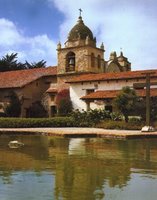Open Thread for Friday
 Continuing our theme of California's Missions, today, Mission San Carlos Borroméo de Carmelo.
Continuing our theme of California's Missions, today, Mission San Carlos Borroméo de Carmelo.The Carmel Mission...
When it was agreed that the second mission should be established on Vizcaino's Monterey Bay, Governor Portola went by land, but Father Serra went by sea. After both parties met at the evergreen-scented harbor, Portola realized he had failed to recognize the place on his land expedition of the year before, while searching for that same harbor.
Two days after his arrival, on June 3, 1770, Father Serra founded his Mission San Carlos Borromeo at the site of the present presidio Chapel in Monterey. Only a year later the padre again separated his Indian charges from the Spanish soldiers, moving the mission five miles away to the Carmel Valley, on the other side of the Monterey Peninsula. At that lovely place Father Serra established his personal headquarters. Monterey became an important port and the capital city of the Californias.
Father Serra did not live to see the period of greatest prosperity of the California missions, nor the building of the impressive monuments we see along El Camino Real today. Most of the churches, even so, were built only of adobe with thick, plastered walls. Just at Carmel, and three other locations, were there enough skilled artisans present to design and build with stone.
The stone church at Carmel is different from all others in the chain, in that the walls taper inward forming a catenary arch, rather than the usual flat ceiling. On the exterior, the unique bell tower, with its outside stairway, shows definite Moorish influence. The great church was four years in the building, being dedicated in 1797. Father Serra now lies buried under the altar.
The Indian population had dwindled by the 1820s. By 1836, two years after secularization, the destruction of mission life was complete. The church and quadrangle were essentially in ruins when the first efforts at restoration began in 1884. Then in 1931, a layman, Harry Downie, came to Carmel, as curator in charge of restoring the mission. From that time until his death in 1980, Harry dedicated his life to the California missions, working on numerous other restorations as well as at his beloved Carmel.
The Carmel Mission was Fr. Serra's favorite, and he lies buried under the altar in his beautiful church, the second founded in the California chain. On its splendid site at the mouth of the Carmel Valley and overlooking the sea, the old mission has survived years of neglect and is now one of the outstanding historic landmarks in California. Much of the stateliness of its early days has been recaptured in the careful restoration of the buildings, while the beauty of its gardens is unsurpassed. The Moorish influence in the architecture of the church is unique.
California Mission History
Previously
Mission San Fernando Rey de Espana
Mission Santa Cruz
Mission San Francisco de Solano
Mission San Luis Rey
Mission San Buenaventura
Mission San Rafael
Mission San Gabriel Arcángel
Mission Nuestra Señora de la Soledad
Mission San Francisco de Asís
Mission San Juan Capistrano
Mission San Jose
Mission La Purisima Concepción




0 Comments:
Post a Comment
Subscribe to Post Comments [Atom]
<< Home